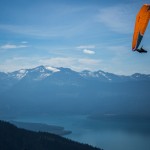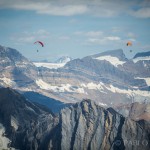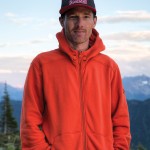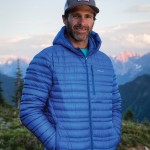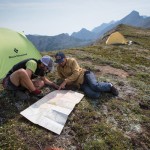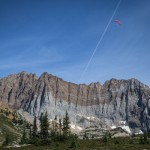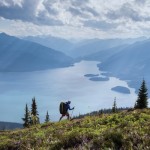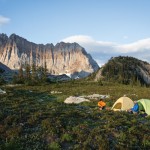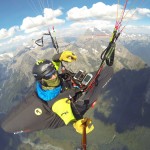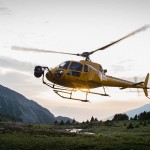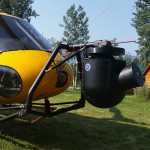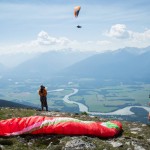Watch a teaser of the film by Red Bull which will be released next year:
By: Laura Keil
Paragliding record-setters Will Gadd and Gavin McClurg are nominated as National Geographic’s Adventurers of the Year 2015 after their epic paragliding journey from McBride, B.C. to the U.S. border this summer.
The adventure began on a ridge of Teare Mountain. It’s a big blue sky. Their paragliding gear is ready. The pair wait for the right moment to take off – and for the helicopter to arrive.
“It’s one of those all-time great summer days right now,” Gadd said into his cellphone to the Goat.
The excitement is palpable in his voice. This is the big beginning.
It’s August 1st and McClurg, 42, and Gadd, 47, – who just met for the first time – plan to spend three weeks in the alpine, with nothing but the gear attached to their paragliders. They will fly from McBride to Mt. Robson and then veer south, using only their paragliders to propel them towards their goal: the U.S. border, some 650km away. They want a continuous flying GPS trace of the whole trip. Most of this area – heavily treed with few roads or people – has never before been charted by paraglider.
The pair will cross remote mountain ranges seldom seen by humans. The film crew hired by Red Bull to document the journey won’t be carrying any of their supplies. They will have to navigate in remote areas and wait out bad weather.
In reality, the journey takes the pair 35 days, logging 800km, partly due to poor conditions. They get stuck for four days on Kinbasket Lake. They are forced to change their route due to forest fires, backtrack to keep their GPS track continuous, and fly for as long as 100km without finding a good spot to land.
“Flying in the mountains is much harder than flying on the flat,” Gadd said in an interview with the Goat. “It’s much harder to fly in the mountains because the mountains get in the way. It’s a much more technical thing.”
“If the flying conditions are good, it will be difficult, but if they’re bad there’s no chance of success,” he was quoted in a Red Bull interview before the trip.
Despite the known and unknown challenges, the journey also offers them chances of a lifetime. After they launch from McBride, the pair heads southeast towards Mt. Robson, using thermal lifts of air to keep them aloft. They glide towards Canada’s highest peak in the Rocky Mountain Range, its imposing south face pulling them upward at thousands of feet per minute. The A-star helicopter carrying the film crew could not keep up with them. McClurg says he could hear Gadd laughing maniacally as they were swept up and high above Mt. Robson’s summit.
Each night the pair camped in alpine meadows. This way of paragliding and camping is known as “Vol-Bivy” and is not as common in North America as it is in Europe. It can allow the flyer to explore multiple peaks in a single day, remaining up high as long as they can find thermal pockets to buoy them back into the sky.
“There was a day where we flew 50 miles without a single place to land,” McClurg was quoted in National Geographic. McClurg currently holds the North American record for the longest single paragliding flight (390km) where the pilot launched by foot. “That was special. It made me shift how I think about flying.”
If they don’t find any thermal pockets, the consequences can be grim if their altitude is low – landing in trees or rivers are dangers.
When conditions were good, they could cover 100km. But poor conditions meant that on many days they could only fly maybe 25km.
McClurg says flying through that terrain was “absolutely terrifying.”
“You just don’t fly over terrain where you can’t land, and we had to do it continuously.”
It’s the longest true paragliding trip ever attempted and expands what people think is possible with paragliding.
You can vote for Will Gadd and Gavin McClurg on the National Geographic website as Adventurers of the Year 2015 every day from now until Jan. 31st.
http://adventure.nationalgeographic.com/adventure/adventurers-of-the-year/2015/vote/



